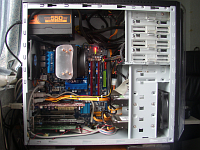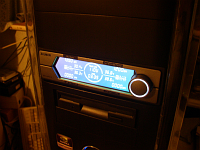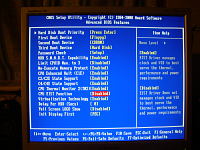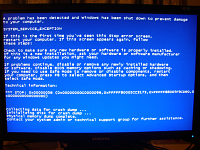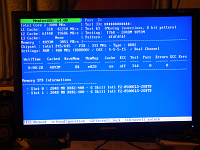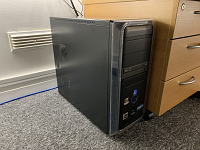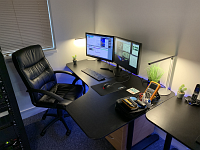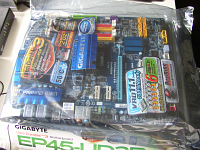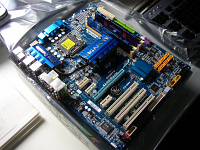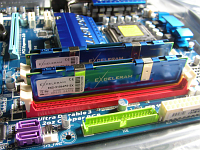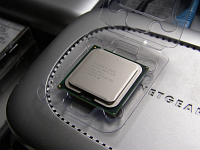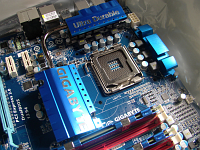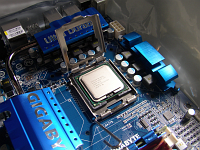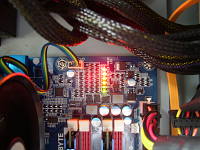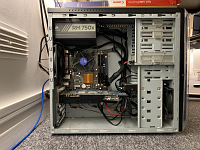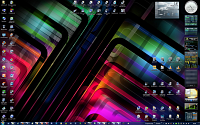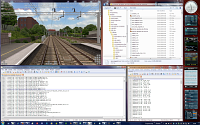Development PC(s) and Network - Introduction

Within the Development PC(s) and Network Section:
- The software I use for development →
- Computer Hardware - Current Systems (2014 - Present) →
- Computer Hardware - Previous Systems (1998 - 2014) →
- Computer Hardware - Historic Systems (Pre-BVE: 1994 - 1998) →
- Office/Lab (2018 - Present)→
- Server Setup (2016 - Present) →
The Intel Core 2 Quad Q9650 System (2009 - 2014)
This previous main development system was built to be fast enough to cope with anything I'd have been likely to be doing for quite some time, although I only used it for tasks which required high performance hardware (for everything else, I used my secondary development PC which had lower power consumption). Faster hardware consumed more power, so power saving technologies were enabled as well, and the CPU wasn't regularly overclocked so it'd have a longer life. Interestingly, this quad core CPU based system with 24" widescreen TFT monitor, consumed less power under light load, than the earlier AthlonXP 2400+ based system with a 17" CRT did when it was idle, despite the new system being so much more powerful.
I installed a Zalman fan controller in a spare 5 1/2 inch drive bay in this system to manage thermal performance, and the controller included a VFD (Vacuum Flourescent Display) for monitoring purposes. This is now in use in the Core i7 4770K system and still going strong. I initially had repeated problems with RAM instability on this Core 2 Quad system, causing random BSoDs (Blue Screens of Death) in Windows. Reducing the DDR data rate helped, but ultimately the problem was solved by using RAM from a different manufacturer. After this, the system was stable and a pleasure to use. The following openBVE add-ons were developed on it:
- Birmingham Cross-City South v2.0
- Watford Junction to Rugby
Gallery
Specifications
CPU:
Intel Core 2 Quad Q9650 [Yorkfield Core, 45nm, 3.00GHz, 1333MHz FSB, 12MB Cache, E0 Stepping]
-- 3DMark06 (Default Settings) - CPU Score: 4981
-- Windows 7 Experience Index (Processor) - 7.3
SiSoftware Sandra Lite 2010
Aggregate Arithmetic Performance: 52 GOPS
Dhrystone ALU: 63.57 GIPS
Whetstone iSSE3: 40.36 GFLOPS
Cooling: Akasa AK-965 heat-pipe cooler with 92mm fan
-- 3DMark06 (Default Settings) - CPU Score: 4981
-- Windows 7 Experience Index (Processor) - 7.3
SiSoftware Sandra Lite 2010
Aggregate Arithmetic Performance: 52 GOPS
Dhrystone ALU: 63.57 GIPS
Whetstone iSSE3: 40.36 GFLOPS
Cooling: Akasa AK-965 heat-pipe cooler with 92mm fan
Motherboard:
Asus P5QPL-AM rev. 1.04G, BIOS ver. 0414 [Northbridge: Intel G41 Express (Eaglelake (G)), Southbridge: Intel ICH7; Socket 775, microATX form factor]
Previously:
Gigabyte GA-EP45-UD3R rev. 1.1, BIOS ver. F12 [Northbridge: Intel P45 Express (Eaglelake (P+)), Southbridge: Intel ICH10R; Socket 775, ATX form factor]
Previously:
Gigabyte GA-EP45-UD3R rev. 1.1, BIOS ver. F12 [Northbridge: Intel P45 Express (Eaglelake (P+)), Southbridge: Intel ICH10R; Socket 775, ATX form factor]
RAM:
4GB PC2-6400 DDR2 SDRAM [CL5-5-5-15, Dual channel]
SiSoftware Sandra Lite 2010
Int Buff'd iSSE2 Memory Bandwidth: [7.14 GB/s]
Float Buff'd iSSE2 Memory Bandwidth: [7.16 GB/s]
Memory (Random Access) Latency: [81 ns]
Memory (Linear Access) Latency: [11 ns]
Windows 7 Experience Index (RAM): [7.3]
SiSoftware Sandra Lite 2010
Int Buff'd iSSE2 Memory Bandwidth: [7.14 GB/s]
Float Buff'd iSSE2 Memory Bandwidth: [7.16 GB/s]
Memory (Random Access) Latency: [81 ns]
Memory (Linear Access) Latency: [11 ns]
Windows 7 Experience Index (RAM): [7.3]
Graphics:
NVIDIA GeForce GTX 260, 896MB, PCI-E 2.0(x16) [GT200b GPU, 55nm, 216 Cores, Core: 590MHz, Mem: 999MHz Shader: 1296MHz]
[GeForce 342.01 drivers]
3DMark06 Basic v1.0.2 (Default Settings)
SM2.0 Score: [--]
HDR/SM3.0 Score: [--]
FurMark v1.6.5 (AAx8, AFx16, 1280x1024, Time: 60000ms)
o3Marks: [--]
FPS (min/max/avg.): [-- / -- / --]
openBVE framerates
(Windows 7 64-bit, 600m viewing distance, Anisotropic filtering (Sharp), fullscreen 1920x1200, AA: 16xQ, AF: 16x):
Cross-City South v1.31 High Detail, Redditch, with class 323 3D cab: [-- fps]
Cross-City South v1.31 High Detail, Barnt Green, with class 323 3D cab: [-- fps]
Windows 7 Experience Index (Graphics): [--]
[GeForce 342.01 drivers]
3DMark06 Basic v1.0.2 (Default Settings)
SM2.0 Score: [--]
HDR/SM3.0 Score: [--]
FurMark v1.6.5 (AAx8, AFx16, 1280x1024, Time: 60000ms)
o3Marks: [--]
FPS (min/max/avg.): [-- / -- / --]
openBVE framerates
(Windows 7 64-bit, 600m viewing distance, Anisotropic filtering (Sharp), fullscreen 1920x1200, AA: 16xQ, AF: 16x):
Cross-City South v1.31 High Detail, Redditch, with class 323 3D cab: [-- fps]
Cross-City South v1.31 High Detail, Barnt Green, with class 323 3D cab: [-- fps]
Windows 7 Experience Index (Graphics): [--]
Audio:
On-board Realtek ALC887 High Definition Audio 6-channel CODEC
Edifier M1550 5.1 Surround Multimedia Speakers
Edifier M1550 5.1 Surround Multimedia Speakers
Internal Storage:
Currently:
Corsair 240GB Force 3 SSD (CSSD-F240GB3-BK) 240GB 2.5" SSD [SATA-III 6Gb/s, 64MB Cache, AHCI, APM, NCQ, TRIM]
ATTO Disk Benchmark (default settings)
Max Read Transfer Rate: -- [KB/s]
Max Write Transfer Rate: -- [KB/s]
Min Read Transfer Rate: -- [KB/s]
Min Write Transfer Rate: -- [KB/s]
SiSoft Sandra Lite 2018SP2c
Read Performance: [-- MB/s]
Random access time: [- ms]
Samsung HD103SJ Spinpoint F3 1TB 3.5" [SATA-II 3Gb/s, 7200rpm, 32MB Cache, AHCI, NCQ, Firmware 1AJ10001]
ATTO Disk Benchmark (default settings)
Max Read Transfer Rate: [140651 KB/s]
Max Write Transfer Rate: [146140 KB/s]
Min Read Transfer Rate: [19662 KB/s]
Min Write Transfer Rate: [17152 KB/s]
Previously:
Western Digital VelociRaptor WD1500HLFS-01G6U1 150GB 2.5" [SATA-II 3Gb/s, 10000rpm, 16MB Cache, AHCI, Firmware v04.04V02]
ATTO Disk Benchmark (default settings)
Max Read Transfer Rate: [126028 KB/s]
Max Write Transfer Rate: [128159 KB/s]
Min Read Transfer Rate: [11307 KB/s]
Min Write Transfer Rate: [10772 KB/s]
SiSoft Sandra Lite 2010
Read Performance: [74 - 121.72 MB/s]
Random access time: [6.87 ms]
Windows 7 Experience Index (Hard Disk): [5.9]
SiSoft Sandra Lite 2010
Read Performance: [82.3 - 153 MB/s]
Random access time: [13 ms]
Windows 7 Experience Index (Hard Disk): [5.9]
Western Digital WD1002FAEX Caviar Black 1TB 3.5" [SATA-III 6Gb/s (limited to 3Gb/s), 7200rpm, 64MB Cache, AHCI, NCQ, Firmware v05.01D05]
ATTO Disk Benchmark (default settings)
Max Read Transfer Rate: [138845 KB/s]
Max Write Transfer Rate: [129678 KB/s]
Min Read Transfer Rate: [5535 KB/s]
Min Write Transfer Rate: [5296 KB/s]
SiSoft Sandra Lite 2010
Read Performance: [60.61 - 140.65 MB/s]
Random access time: [13 ms]
Windows 7 Experience Index (Hard Disk): [5.9]
The SSD is used to store the operating system only, in order to minimise the amount of writes to the SSD, and hence maximise the life expectency of the drive's MLC NAND flash cells.
Corsair 240GB Force 3 SSD (CSSD-F240GB3-BK) 240GB 2.5" SSD [SATA-III 6Gb/s, 64MB Cache, AHCI, APM, NCQ, TRIM]
ATTO Disk Benchmark (default settings)
Max Read Transfer Rate: -- [KB/s]
Max Write Transfer Rate: -- [KB/s]
Min Read Transfer Rate: -- [KB/s]
Min Write Transfer Rate: -- [KB/s]
SiSoft Sandra Lite 2018SP2c
Read Performance: [-- MB/s]
Random access time: [- ms]
Samsung HD103SJ Spinpoint F3 1TB 3.5" [SATA-II 3Gb/s, 7200rpm, 32MB Cache, AHCI, NCQ, Firmware 1AJ10001]
ATTO Disk Benchmark (default settings)
Max Read Transfer Rate: [140651 KB/s]
Max Write Transfer Rate: [146140 KB/s]
Min Read Transfer Rate: [19662 KB/s]
Min Write Transfer Rate: [17152 KB/s]
Previously:
Western Digital VelociRaptor WD1500HLFS-01G6U1 150GB 2.5" [SATA-II 3Gb/s, 10000rpm, 16MB Cache, AHCI, Firmware v04.04V02]
ATTO Disk Benchmark (default settings)
Max Read Transfer Rate: [126028 KB/s]
Max Write Transfer Rate: [128159 KB/s]
Min Read Transfer Rate: [11307 KB/s]
Min Write Transfer Rate: [10772 KB/s]
SiSoft Sandra Lite 2010
Read Performance: [74 - 121.72 MB/s]
Random access time: [6.87 ms]
Windows 7 Experience Index (Hard Disk): [5.9]
SiSoft Sandra Lite 2010
Read Performance: [82.3 - 153 MB/s]
Random access time: [13 ms]
Windows 7 Experience Index (Hard Disk): [5.9]
Western Digital WD1002FAEX Caviar Black 1TB 3.5" [SATA-III 6Gb/s (limited to 3Gb/s), 7200rpm, 64MB Cache, AHCI, NCQ, Firmware v05.01D05]
ATTO Disk Benchmark (default settings)
Max Read Transfer Rate: [138845 KB/s]
Max Write Transfer Rate: [129678 KB/s]
Min Read Transfer Rate: [5535 KB/s]
Min Write Transfer Rate: [5296 KB/s]
SiSoft Sandra Lite 2010
Read Performance: [60.61 - 140.65 MB/s]
Random access time: [13 ms]
Windows 7 Experience Index (Hard Disk): [5.9]
The SSD is used to store the operating system only, in order to minimise the amount of writes to the SSD, and hence maximise the life expectency of the drive's MLC NAND flash cells.
Optical Storage:
Samsung SH-S223L/BEBE 22x DVD±R, 8x DVD±DL, DVD+RW x8/-RW x6, x12 RAM w. Lightscribe (SATA, Firmware v. SB02)
Display:
Asus VS24AHL 24" TFT/IPS LCD @ 1920x1200
Samsung Syncmaster 2443BW 24" 5ms TFT/TN LCD @ 1920x1200 [Samsung panel]
Samsung Syncmaster 2443BW 24" 5ms TFT/TN LCD @ 1920x1200 [Samsung panel]
Input:
Matias Wired RGB Backlit Aluminium Keyboard (FK318PCLBB-UK)
Logitech MX400 Performance Laser Mouse
Logitech MX400 Performance Laser Mouse
TV Card:
Previously: Hauppauge WinTV-HVR 900H Hybrid TV Stick
Case:
akasa Zen Silent-Cool [Black]
Power Supply:
Corsair 750 Watt RM750x Fully Modular ATX PSU
Previously: Corsair VX550W ATX12V v2.2 [80 Plus, +3.3V: 30A, +5V: 20A, +12V: 41A]
Information: After having three cheap PSUs fail previously, I fitted decent PSUs in my systems. Both PSUs were/are capable of delivering more power than is needed, giving longer life due no over-stressing.
Previously: Corsair VX550W ATX12V v2.2 [80 Plus, +3.3V: 30A, +5V: 20A, +12V: 41A]
Information: After having three cheap PSUs fail previously, I fitted decent PSUs in my systems. Both PSUs were/are capable of delivering more power than is needed, giving longer life due no over-stressing.
Internet and LAN:
Atheros L1E Gigabit LAN PCIe (10/100/1000 Mbps)
Operating System(s):
Currently: Windows 7 Professional 64-bit
Previously: Windows 7 Home Premium 64-Bit (Service Pack 1)
Windows Experience Index: [7.2]
Processor: [7.3]
Memory: [7.3]
Graphics: [7.2]
Gaming graphics: [7.2]
Primary hard disk: [7.2]
Previously: Windows 7 Home Premium 64-Bit (Service Pack 1)
Windows Experience Index: [7.2]
Processor: [7.3]
Memory: [7.3]
Graphics: [7.2]
Gaming graphics: [7.2]
Primary hard disk: [7.2]
Return to the Development PC(s) and Network Menu
Content last updated: 10th April 2019

